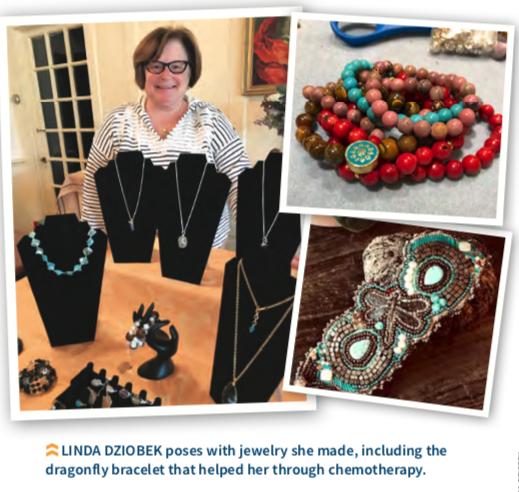Article
Finding Meaning While Waiting in the Infusion Chair
Author(s):
One survivor makes the most of the time in the infusion chair, creating beaded jewelry and helping herself and others to heal.
When Linda Dziobek was lost in chemotherapy-induced brain fog and facing neuropathy that made every movement of her hands a struggle, her love of beading helped heal her. Now the jewelry she makes while sitting in the infusion chair does the same for those around her.
After every treatment at Women & Infants Hospital in Providence, Rhode Island, the 15-year survivor of ovarian cancer adds sparkling creations to an “earring tree” placed there by volunteers. Patients are free to choose from and keep the jewelry that hangs there.

Dziobek also gives away jewelry when she’s treated at Dana-Farber Cancer Institute in Boston. She has made rings for patients whose swollen fingers are too large for standard sizes and instructed others in bracelet-making techniques.
“It makes people feel good and doing something productive while I’m here gives me purpose,” Dziobek, a retired nurse, says. “A couple of months ago, a woman told me that my blue earrings were the only ones she could find that matched her dress for her daughter’s wedding. She was in the middle of her treatment and had no hair, but she had a beautiful scarf with the earrings to match her dress. It really helped, and she couldn’t thank me enough. I had tears in my eyes; it was like a connection was made. You don’t realize the impact you have when you do something like this.”
Dziobek picked up her hobby in 2010 and was taking classes at a bead store when she experienced a recurrence of her cancer, first diagnosed in 2004. After radiation, she joined a clinical trial of intraperitoneal chemotherapy plus the targeted drug Velcade (bortezomib), but complications arose after one treatment, and she needed surgery. That was followed by six months of intravenous chemotherapy.
While recovering, Dziobek periodically reflected on a cuff bracelet she’d begun before treatment. Although she was not sure if she would be able to follow the directions or do the intricate beading work due to her brain fog and neuropathy, she returned to her project. It took her three months to finish.
“It helped me to focus, and I started to come out of the fog of chemo brain and my hands felt better,” she recalls.
“I felt like I was creating new pathways in my brain by focusing and figuring out color palette, placement of beads and measurements.”
Dziobek was still part of the beading group, and her fellow members decided to help other patients enjoy a similar experience. They developed the Plum Blossom Project, bringing beaders to cancer centers to instruct patients in making bracelets. After completing a piece, each patient was gifted a beaded necklace made by volunteers. Dziobek’s husband, Joe, helped raise funds for the project by selling CDs of two songs he wrote and performed, one about Plum Blossom and the other about the caregiver’s journey (youtube. com/watch?v=cd3DotLtwrE).
The group recently stopped working with patients who have cancer, but a few years ago Dziobek invited members to give a class for the gynecologic cancers support group at Women & Infants, where she goes twice a week for magnesium infusions to treat a long-term side effect of chemotherapy.
It made a difference for participants, especially one woman and her daughter.
“The mom, who had been in treatment all day, wanted to take the class, but the daughter was burnt out and wanted to get home,” Dziobek recalls. “In the 15 to 20 minutes that they were selecting beads and putting their bracelets together, we could see the daughter’s shoulders and facial muscles relax, and the conversation changed. By the time they left, rather than a stressed-out caregiver taking care of a relative, it was now a mother-daughter relationship. They were excited about the bracelets they’d made, and their whole demeanor changed.”
Their story is a reminder, Dziobek says, of the importance of finding something enjoyable to do during cancer treatment, an idea she keeps front of mind as she prepares to enter a clinical trial at Dana-Farber.
“Treatment really wears you down and the toll is cumulative, but if there’s something you can do to help yourself at least feel a little better, do it,” suggests Dziobek, who also finds meaning by volunteering with the Partnership to Reduce Cancer in Rhode Island, a community advisory group that works with the state health department’s comprehensive cancer control program.
The partnership holds an annual June cancer summit, for which Dziobek is planning a survivor-led presentation to show participants how to make meditation bracelets and emphasize the health benefits of beading.
“I firmly believe that we have to have some purpose each day and something to look forward to, no matter how we feel,” she says. “It continues to give you hope and keeps you moving forward.”





